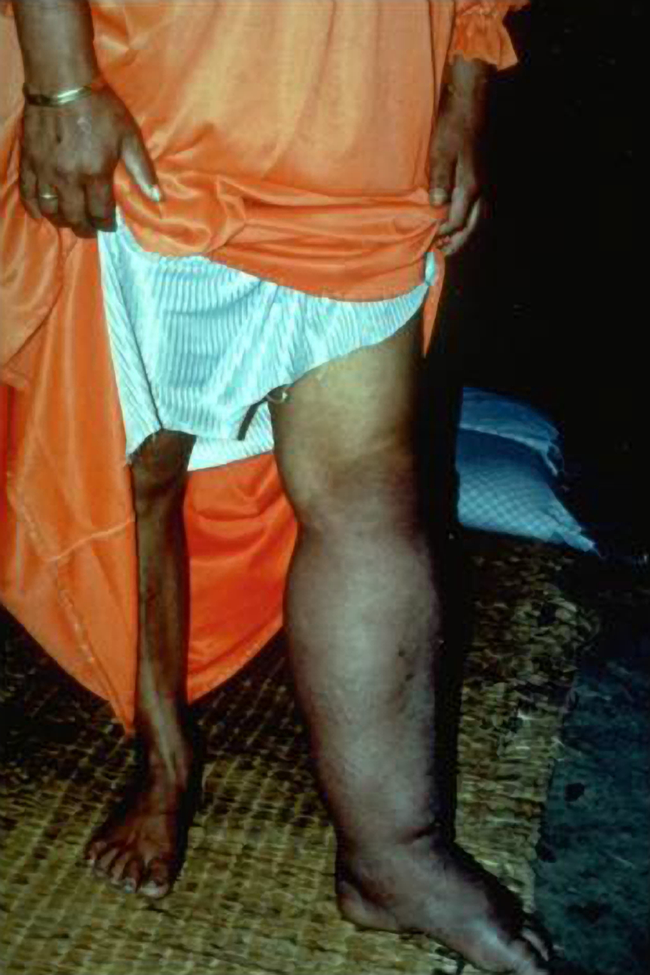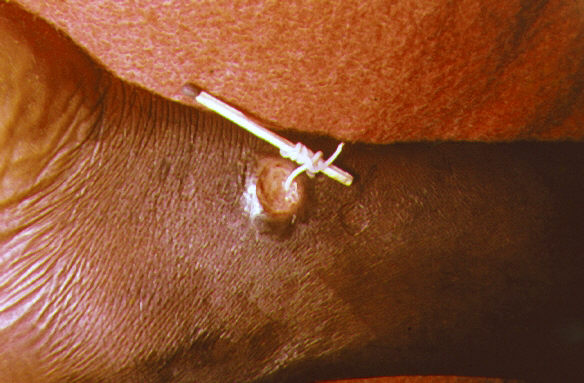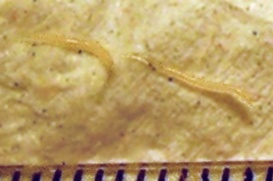|
Parasitic Worms (other)
Parasitic worm, known for flukes and intestinal worms, may refer to: * Acanthocephala, or the spiny-headed worms all of which are parasitic. * Helminth collectively describes the unrelated "worm-like" groups platyhelminthes and nematoda * Hirudinea, extoparasitic annelids commonly known as leeches * Nematoda, or roundworms the most well known of which are parasitic ** Enterobius, commonly known as pinworms, cause the disease enterobiasis. ** Hookworms, intestinal parasites of mammals. * Pentastomida, sometimes referred to as tongue worms which are obligate parasites * Platyhelminthes, or flatworms the phyla which contains the parasitic tapeworms and flukes. ** Liver fluke ** Blood fluke ** Lung fluke ** Intestinal fluke Parasitic worm infection * Tapeworm infection * Deworming * Effects of parasitic worms on the immune system * Coenurosis, intermediate infection of host ** Coenurosis in humans * Enterobiasis, pinworm infection * Echinococcosis, host disease by tapeworm larve ... [...More Info...] [...Related Items...] OR: [Wikipedia] [Google] [Baidu] |
Acanthocephala
Acanthocephala (Greek , ', thorn + , ', head) is a phylum of parasitic worms known as acanthocephalans, thorny-headed worms, or spiny-headed worms, characterized by the presence of an eversible proboscis, armed with spines, which it uses to pierce and hold the gut wall of its host. Acanthocephalans have complex life cycles, involving at least two hosts, which may include invertebrates, fish, amphibians, birds, and mammals. About 1420 species have been described. The Acanthocephala were thought to be a discrete phylum. Recent genome analysis has shown that they are descended from, and should be considered as, highly modified rotifers. This unified taxon is known as Syndermata. History The earliest recognisable description of Acanthocephala – a worm with a proboscis armed with hooks – was made by Italian author Francesco Redi (1684).Crompton 1985, p. 27 In 1771, Joseph Koelreuter proposed the name Acanthocephala. Philipp Ludwig Statius Müller independently called th ... [...More Info...] [...Related Items...] OR: [Wikipedia] [Google] [Baidu] |
Effects Of Parasitic Worms On The Immune System
The effects of parasitic worms, or helminths, on the immune system is a recently emerging topic of study among immunologists and other biologists. Experiments have involved a wide range of parasites, diseases, and hosts. The effects on humans have been of special interest. The tendency of many parasitic worms to pacify the host's immune response allows them to mollify some diseases, while worsening others. Immune response hypothesis Mechanisms of immune regulation Extensive research shows that parasitic worms have the ability to deactivate certain immune system cells, leading to a gentler immune response.Cooke 2008, pp. 12-14Melendez 2007, p. 1375Bashir 2002, p. 3284Moreels 2004, p. 99Weinstock 2005, pp. 249-251Correale 2007, pp. 98-99 Often, such a response is beneficial to both parasite and host, according to Graham Rook, a professor of medical microbiology at University College London.Rook 2008, pp. 3-4 This immune "relaxation" is incorporated throughout the immune system, ... [...More Info...] [...Related Items...] OR: [Wikipedia] [Google] [Baidu] |
Ringworm
Dermatophytosis, also known as ringworm, is a fungal infection of the skin. Typically it results in a red, itchy, scaly, circular rash. Hair loss may occur in the area affected. Symptoms begin four to fourteen days after exposure. Multiple areas can be affected at a given time. About 40 types of fungus can cause ringworm. They are typically of the ''Trichophyton'', ''Microsporum'', or ''Epidermophyton'' type. Risk factors include using public showers, contact sports such as wrestling, excessive sweating, contact with animals, obesity, and poor immune function. Ringworm can spread from other animals or between people. Diagnosis is often based on the appearance and symptoms. It may be confirmed by either culturing or looking at a skin scraping under a microscope. Prevention is by keeping the skin dry, not walking barefoot in public, and not sharing personal items. Treatment is typically with antifungal creams such as clotrimazole or miconazole. If the scalp is involved, ant ... [...More Info...] [...Related Items...] OR: [Wikipedia] [Google] [Baidu] |
Parasitic Nutrition
Parasitism is a close relationship between species, where one organism, the parasite, lives on or inside another organism, the host, causing it some harm, and is adapted structurally to this way of life. The entomologist E. O. Wilson has characterised parasites as "predators that eat prey in units of less than one". Parasites include single-celled protozoans such as the agents of malaria, sleeping sickness, and amoebic dysentery; animals such as hookworms, lice, mosquitoes, and vampire bats; fungi such as honey fungus and the agents of ringworm; and plants such as mistletoe, dodder, and the broomrapes. There are six major parasitic strategies of exploitation of animal hosts, namely parasitic castration, directly transmitted parasitism (by contact), trophicallytransmitted parasitism (by being eaten), vector-transmitted parasitism, parasitoidism, and micropredation. One major axis of classification concerns invasiveness: an endoparasite lives inside the host's body; an ect ... [...More Info...] [...Related Items...] OR: [Wikipedia] [Google] [Baidu] |
Human Parasites
Human parasites include various protozoa and worms. Human parasites are divided into endoparasites, which cause infection inside the body, and ectoparasites, which cause infection superficially within the skin. The cysts and eggs of endoparasites may be found in feces, which aids in the detection of the parasite in the human host while also providing the means for the parasitic species to exit the current host and enter other hosts. Although there are a number of ways in which humans can contract parasitic infections, observing basic hygiene and cleanliness tips can reduce its probability. The most accurate diagnosis is by qPcr DNA antigen assay, not generally available by primary care physicians in the USA: most labs offer research only service. History Archaeological evidence It was assumed that early human ancestors generally had parasites, but until recently there was no evidence to support this claim. Generally, the discovery of parasites in ancient humans relies on the ... [...More Info...] [...Related Items...] OR: [Wikipedia] [Google] [Baidu] |
Parasitology
Parasitology is the study of parasites, their hosts, and the relationship between them. As a biological discipline, the scope of parasitology is not determined by the organism or environment in question but by their way of life. This means it forms a synthesis of other disciplines, and draws on techniques from fields such as cell biology, bioinformatics, biochemistry, molecular biology, immunology, genetics, evolution and ecology. Fields The study of these diverse organisms means that the subject is often broken up into simpler, more focused units, which use common techniques, even if they are not studying the same organisms or diseases. Much research in parasitology falls somewhere between two or more of these definitions. In general, the study of prokaryotes falls under the field of bacteriology rather than parasitology. Medical The parasitologist F.E.G. Cox noted that "Humans are hosts to nearly 300 species of parasitic worms and over 70 species of protozoa, some derived f ... [...More Info...] [...Related Items...] OR: [Wikipedia] [Google] [Baidu] |
Parasitoids
In evolutionary ecology, a parasitoid is an organism that lives in close association with its host at the host's expense, eventually resulting in the death of the host. Parasitoidism is one of six major evolutionary strategies within parasitism, distinguished by the fatal prognosis for the host, which makes the strategy close to predation. Among parasitoids, strategies range from living inside the host (''endoparasitism''), allowing it to continue growing before emerging as an adult, to paralysing the host and living outside it (''ectoparasitism''). Hosts can include other parasitoids, resulting in hyperparasitism; in the case of oak galls, up to five levels of parasitism are possible. Some parasitoids influence their host's behaviour in ways that favour the propagation of the parasitoid. Parasitoids are found in a variety of taxa across the insect superorder Endopterygota, whose complete metamorphosis may have pre-adapted them for a split lifestyle, with parasitoid l ... [...More Info...] [...Related Items...] OR: [Wikipedia] [Google] [Baidu] |
Nematomorpha
Nematomorpha (sometimes called Gordiacea, and commonly known as horsehair worms, hairsnakes, or Gordian worms) are a phylum of parasitoid animals superficially similar to nematode worms in morphology, hence the name. Most species range in size from long, reaching 2 metres in extreme cases, and in diameter. Horsehair worms can be discovered in damp areas, such as watering troughs, swimming pools, streams, puddles, and cisterns. The adult worms are free-living, but the larvae are parasitic on arthropods, such as beetles, cockroaches, mantises, orthopterans, and crustaceans. About 351 freshwater species are known and a conservative estimate suggests that there may be about 2000 freshwater species worldwide. The name "Gordian" stems from the legendary Gordian knot. This relates to the fact that nematomorphs often coil themselves in tight balls that resemble knots. Description and biology Nematomorphs possess an external cuticle without cilia. Internally, they have only longitudin ... [...More Info...] [...Related Items...] OR: [Wikipedia] [Google] [Baidu] |
Helminthiasis
Helminthiasis, also known as worm infection, is any macroparasitic disease of humans and other animals in which a part of the body is infected with parasitic worms, known as helminths. There are numerous species of these parasites, which are broadly classified into tapeworms, flukes, and roundworms. They often live in the gastrointestinal tract of their hosts, but they may also burrow into other organs, where they induce physiological damage. Soil-transmitted helminthiasis and schistosomiasis are the most important helminthiases, and are among the neglected tropical diseases. These group of helminthiases have been targeted under the joint action of the world's leading pharmaceutical companies and non-governmental organizations through a project launched in 2012 called the London Declaration on Neglected Tropical Diseases, which aims to control or eradicate certain neglected tropical diseases by 2020. Helminthiasis has been found to result in poor birth outcome, poor cogniti ... [...More Info...] [...Related Items...] OR: [Wikipedia] [Google] [Baidu] |
Echinococcosis
Echinococcosis is a parasitic disease of tapeworms of the ''Echinococcus'' type. The two main types of the disease are ''cystic echinococcosis'' and ''alveolar echinococcosis''. Less common forms include ''polycystic echinococcosis'' and ''unicystic echinococcosis''. The disease often starts without symptoms and this may last for years. The symptoms and signs that occur depend on the cyst's location and size. ''Alveolar'' disease usually begins in the liver, but can spread to other parts of the body, such as the lungs or brain. When the liver is affected, the patient may experience abdominal pain, weight loss, along with yellow-toned skin discoloration from developed jaundice. Lung disease may cause pain in the chest, shortness of breath, and coughing. The infection is spread when food or water that contains the eggs of the parasite is ingested or by close contact with an infected animal. The eggs are released in the stool of meat-eating animals that are infected by the parasi ... [...More Info...] [...Related Items...] OR: [Wikipedia] [Google] [Baidu] |
Enterobiasis
Pinworm infection (threadworm infection in the UK), also known as enterobiasis, is a human parasitic disease caused by the pinworm. The most common symptom is itching in the anal area. The period of time from swallowing eggs to the appearance of new eggs around the anus is 4 to 8 weeks. Some people who are infected do not have symptoms. The disease is spread between people by pinworm eggs. The eggs initially occur around the anus and can survive for up to three weeks in the environment. They may be swallowed following contamination of the hands, food, or other articles. Those at risk are those who go to school, live in a health care institution or prison, or take care of people who are infected. Other animals do not spread the disease. Diagnosis is by seeing the worms which are about one centimetre long or the eggs under a microscope. Treatment is typically with two doses of the medications mebendazole, pyrantel pamoate, or albendazole two weeks apart. Everyone who lives with ... [...More Info...] [...Related Items...] OR: [Wikipedia] [Google] [Baidu] |
Coenurosis In Humans
Coenurosis is a parasitism, parasitic infection that results when humans ingest the eggs of dog Cestoda, tapeworm species ''Taenia multiceps'', ''Taenia serialis, T. serialis, Taenia brauni, T. brauni,'' or ''Taenia glomerata, T. glomerata.'' It is important to distinguish that there is a very significant difference between intestinal human tapeworm infection and human coenurosis. Humans are the definitive hosts for some tapeworm species, the most common being ''T. saginata'' and ''T. solium'' (beef and pork tapeworms). This means that these species can develop into full grown, reproductively capable adult worms within the human body. People infected with these species have a tapeworm infection. In contrast, the four species that cause human coenurosis can only grow into mature, reproductively capable worms inside their definitive hosts, canids such as dogs, wolves, foxes and coyotes. Humans who ingest eggs from any of these four species of ''Taenia'' become intermediate hosts, or p ... [...More Info...] [...Related Items...] OR: [Wikipedia] [Google] [Baidu] |








